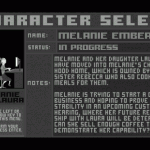Each week in Play in Process, Richard Clark shares what he’s been playing and why it matters.
Is It Time? isn’t fun. It’s not exciting. It’s not addicting. You probably won’t want to play it again after your first session. But you should still play it. It’s not a huge investment: it’s free, you can play it in your browser, and it only takes a few minutes. Go play it now. Then you can keep reading.
What Is It Time? demonstrates so brilliantly is that games can not only incorporate, but excel at causing us to feel a deep empathy for characters, as well as those who we associate with those characters. In this case, the game is about an old woman, but also it’s about what it’s like to be an elderly person in general. Or at least, what it can be like, given the circumstances.
We are faced with an utterly joyless and mundane life – one that primarily involves getting up, walking to the refrigerator, sitting on a park bench with a depressed friend, going back inside, turning on the TV in a last-ditch attempt to stave off boredom, and going back to bed. It’s the small details that really drive home the misery of the situation: the frustratingly slow speed at which our character walks, the daughter who always seems rushed and occupied when she visits, the fact that meatloaf is the only food provided to eat… these things seem like truthful representations of the worst parts of getting old.
Managing all of these things at such a slow pace, and wondering the whole time if it’s even worth it, makes the climax of the game even more effective. We are presented with a choice, of whether or not we’re ready to pass on to the next life or hold on for another day. The first time, I held on because I wanted to see what would happen next. The second time, I held on because I thought that maybe I would get something besides meatloaf the next day. The third time I held on because I thought maybe my friend needed me.
On the fourth day, my friend wasn’t there. It was time.











